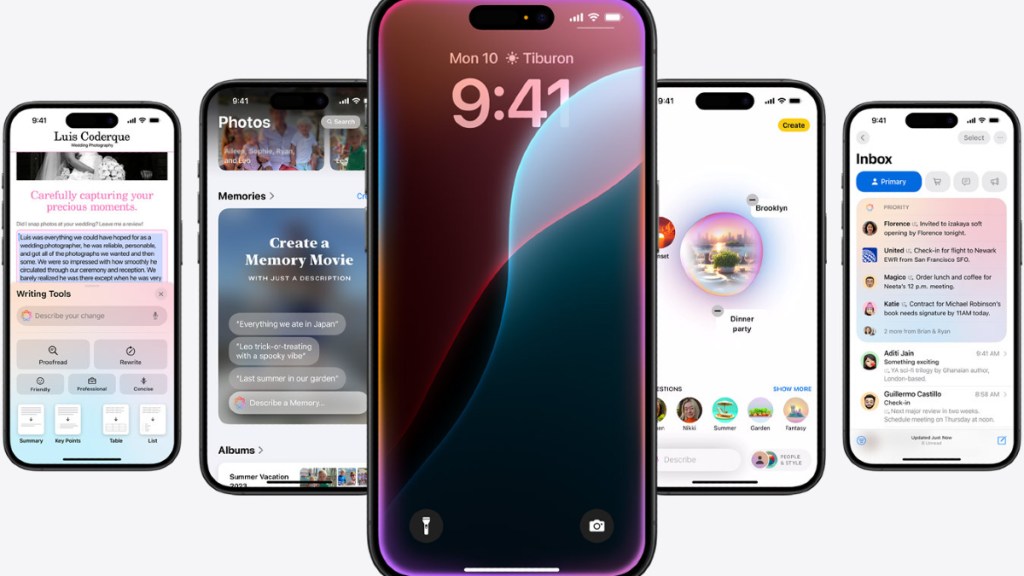Apple has officially entered the AI race. At WWDC 2024 on June 10, Apple unveiled its ambitious AI plans for the iPhone, iPad and Mac—its next big thing if you will. In typical Apple style, it has a fancy new name to go along. Apple calls it the “Apple Intelligence.” The reasoning is that though it is using AI—much like Google and Microsoft—it’s doing it in a very distinct Apple way.
A cornerstone of Apple’s AI strategy is a partnership with OpenAI, to integrate ChatGPT and similar AI capabilities throughout its ecosystem. Siri, Apple’s voice assistant, has also received its most substantial upgrade since its introduction with the iPhone 4S in 2011 all thanks to Apple Intelligence. Using advanced AI and Apple’s precise engineering, this overhaul promises to enhance Siri’s feature set and user experience dramatically.
Apple is using algorithms to determine whether tasks should be processed locally on devices or sent to a cloud server. The company is using Apple silicon in data centres, ensuring remote data processing remains secure with a Secure Enclave.
“We’re thrilled to introduce a new chapter in Apple innovation. Apple Intelligence will transform what users can do with our products — and what our products can do for our users,” said Tim Cook, Apple’s CEO. “Our unique approach combines generative AI with a user’s personal context to deliver truly helpful intelligence. And it can access that information in a completely private and secure way to help users do the things that matter most to them. This is AI as only Apple can deliver it, and we can’t wait for users to experience what it can do.”
Here’s the complete lowdown on Apple Intelligence— top features, device support, availability and more:
- Apple Intelligence availability: Apple Intelligence will be available in beta as part of iOS 18, iPadOS 18, and macOS Sequoia this fall.
- Apple Intelligence eligible devices: The following Apple devices will be eligible for the Apple Intelligence upgrade: iPhone 15 Pro, iPhone 15 Pro Max, iPad Pro M1 and later, iPad Air M1 and later, MacBook Air M1 and later, MacBook Pro M1 and later, iMac M1 and later, Mac Mini M1 and later, Mac Studio M1 Max and later, and M2 Ultra Mac Pro.
Apple Intelligence top features
- General productivity
- Rewrite: Users can leverage Apple Intelligence to choose from different versions of their text, adjusting tone and style to suit the audience and purpose.
- Proofread: Proofread checks for grammar, word choice, and sentence structure, providing suggested edits alongside explanations.
- Summarise: With Summarise, users can choose text and have it condensed into easy to grasp formats like bullet points or tables.
- Priority Messages: A new section within the inbox highlights urgent emails, such as same-day invitations or boarding passes, ensuring crucial information is readily accessible.
- Summary Previews: Instead of previewing the first few lines, emails now display summaries, allowing users to grasp content without opening them. Long threads offer key information with a single tap.
- Smart Reply: Quick response suggestions are provided, with the feature even identifying questions in emails to ensure comprehensive responses.
- Notifications
- Priority Notifications: Important notifications are prioritised at the top of the stack, while summaries enable users to scan lengthy or grouped notifications directly on the Lock Screen.
- Reduce Interruptions Focus: A new Focus mode minimises distractions by displaying only notifications requiring immediate attention.
- Audio recording
- Audio Recording and Summaries: Users can record, transcribe, and summarise audio in the Notes and Phone apps. During calls, the other party is notified of recordings, and post-call, Apple Intelligence generates summaries to aid in recalling key points.
- Image creation
- Image Playground: Integrated into apps like Messages and available as a standalone app, Image Playground lets users create fun images in seconds from Animation, Illustration, or Sketch styles. On iPad, Image Playground is accessible through a new Image Wand in the Apple Pencil tool palette, letting users enrich notes with visually engaging content. Convert rough sketches into delightful images, or create images within empty spaces using context from the surroundings. Image Playground extends to apps like Keynote, Freeform, Pages, and third-party apps adopting the new Image Playground API.
- Genmoji: An extension of Emoji, Genmojis are characters made using text prompts. Genmoji of friends and family can be created based on their photos, and shared as inline messages, stickers, or reactions.
- Intelligent photo and video search: Apple Intelligence allows users to search for specific photos and videos using natural language. Search within videos is upgraded, enabling users to find specific moments quickly, while the Clean Up tool removes distracting background objects without altering the subject.
- Memories: Personalised stories can be created by typing descriptions. Apple Intelligence also gives song suggestions from Apple Music to complement the memory.
Siri: Siri is getting a major upgrade—and a fresh new look! It understands you better now, even if you mess up your words. You can also type your requests to Siri if you prefer. Siri can also do more things for you on your iPhone, iPad, and Mac, and it can answer thousands of questions about how to use them. Siri is also getting smarter about the things you see on your screen, so it can help you with even more tasks across more apps, promising a more integrated and intuitive experience over time.
ChatGPT: Users will gain access to ChatGPT’s capabilities directly on their Apple devices through iOS 18, iPadOS 18, and macOS Sequoia. This partnership allows users to leverage ChatGPT’s expertise in understanding text, images, and documents for a variety of tasks. For instance, Siri can now tap into ChatGPT’s knowledge to answer questions more comprehensively, and the built-in writing tools will be enhanced with features like content generation and image creation. Apple says it will hide users’ IP addresses and OpenAI won’t store requests, while using ChatGPT. However, ChatGPT’s data-use policies will apply when they choose to connect their account.
Follow FE Tech Bytes on Twitter, Instagram, LinkedIn, Facebook.








